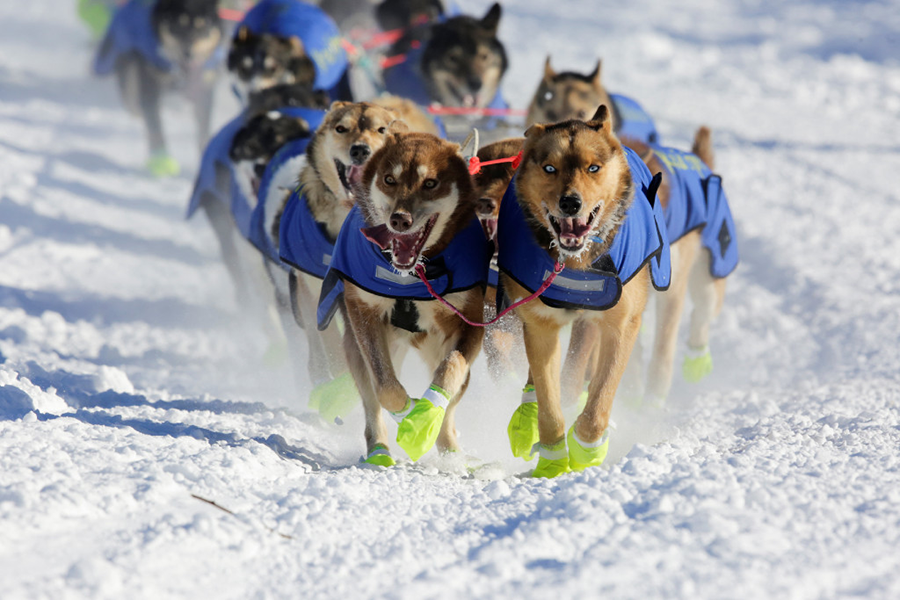In Alaska, 71 mushers kick off the 1,000-mile Iditarod race
Loading...
You have to be the very best of friends to drag a sled almost 1,000 miles through the Alaskan wilderness while battling temperatures dozens of degrees below zero.
But that’s just what the Iditarod entails, with teams of 16 dogs hauling “mushers” in a race that lasts for weeks. The storied competition kicked off Monday as 71 teams embarked on the ultimate test of intra-species cooperation and endurance.
Usually held in Willow, a town 50 miles north of Anchorage, a lack of snow forced a one-day delay this year to allow teams to move 360 miles north to start in Fairbanks.
Not even frigid temperatures of minus 35 degrees Fahrenheit could dampen the spirits of enthusiastic onlookers, who cheered as the teams set off in staggered two-minute shifts.
This year’s entrants range from 20 to 63 years old, and hail from all over the world. Thirteen teams “scratched” – dropped out of the race – before it began, some citing health problems.
The rugged competition pushes participants like no other. Temperatures of minus 75 degrees (pre-windchill) left all contestants with varying degrees of frostbite in 2015, and top finishers must go with little or no sleep for days to traverse the 968 miles of wilderness terrain as fast as they do.
Four-time champion Dallas Seavey holds the record of 8 days, 11 hours, 20 minutes and 16 seconds. He’s racing again this year, but he says he doesn’t have his heart set on a record-tying fifth title. The struggle with nature supersedes the competition with other mushers, making the race unpredictable every time.
"And I'm truly OK with that, as long as I can look back on the race and know I ran my team to the best of their ability, and we all had a good run," Mr. Seavey told the AP.
Last year’s victory netted him a $75,000 prize and a warmer way to get around: a new pickup.
But mushers aren’t in it for the money. On top of a $4,000 entrance fee, the costs of the gear and keeping dogs dwarf potential winnings.
"It's horrifically expensive to maintain a kennel,” retired college professor Cindy Abbott told ABC. "The cost is staggering."
Dr. Abbott says she spent about $70,000 this year on vet bills, meat, dogs, and gear. That pales in comparison to the $95,000 she used to spend while living in California and flying herself and her dogs to Alaska to train, before deciding to relocate to Alaska to focus on the sport full-time. Many highly ranked mushers rely on sponsor support to participate.
But for Abbott, who has completed 1 of 3 Iditarod attempts, testing her endurance is an enlightening experience.
"Every race is a challenge," she told ABC. "It's really hard to run the dogs, to control that power. Each race is a personal accomplishment."
She also summitted Mt. Everest in 2010.
This year, Abbott is one of 17 female mushers. The race hasn’t seen a female victor since the late Susan Butcher in 1990, and Abbott thinks it’s time for another, even though she says she does not expect to be a top finisher.
"That would be awesome," she told the AP.
Other racers have widely varying motivations. Longtime Alaska resident Alan Eischens mushes to raise awareness for pediatric diseases.
"For us, it's about the kids," he told ABC News.
Mr. Eischen trains his dogs year-round through deep snow, rugged trails, and snowstorms so they’ll be ready for anything during the actual race.
"The weather changes so fast.... You're out in the open, in the elements," he said to ABC. "The dogs will shut down if mushers mentally shut down."
To overcome the mental and physical challenges, mushers rely on their dogs, but also each other. Eischen recalls how he thought he’d have to scratch during last year’s race when his sled shattered. Fortunately, a fellow competitor gave him an extra sled, allowing him to finish.
"People watch out for each other out there. We work together as a team. It's camaraderie," he told ABC.








